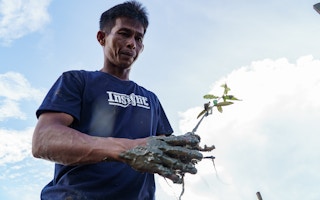Millions of people have joined tree-planting campaigns through the decades - hoping to slow global warming and counteract mass deforestation - but a new study suggests the overall climate benefit has been overstated.
The potential for reforestation projects to mitigate climate change depends largely on where they are located, according to the research, published in the journal Nature Communications.
That is because the pros of new planting could be offset by an often unforeseen con - that fresh tree cover can change the ability of the earth’s surface to reflect sunlight back into space, known as the albedo effect.
From community initiatives to eye-watering pledges from politicians and business, planting trees has become a go-to rallying cry in efforts to tackle climate change. How much this is guided by hope or science, though, is another question.
So does tree planting actually help in the fight against climate change, and where is the ideal place to do it?
Can reforestation help reduce climate change?
The role trees play as “carbon sinks” has a major impact on climate, with the world’s forests absorbing a net 7.6 billion metric tonnes of CO2 per year - about 1.5 times the overall annual emissions of the United States.
Therefore, deforestation of crucial forests such as the Amazon is a major threat to nature’s ability to prevent the worst impacts of climate change.
“
We’re trying to help optimise the largest climate returns per hectare of investment. It remains one of the most cost-effective, scalable carbon removal strategies that we have. But, that said, it doesn’t work as a climate solution everywhere.
Susan Cook-Patton, senior forest restoration scientist, The Nature Conservancy
But throw in the albedo effect and some new tree-planting projects do not cut global warming, according to researchers from Clark University, The Nature Conservancy and ETH-Zurich.
Reforestation is often touted as a silver bullet to the climate crisis, but the new research suggests that the estimated global climate change impact of restoring tree cover may be 20 per cent to 81 per cent too high.
What is the albedo effect?
Along with absorbing CO2, adding trees to a landscape also impacts how solar radiation reflects off the earth.
For example, if a forest is planted where there was previously just snow, the land will reflect less sunlight back into space - hence a lower albedo value.
The level of albedo differs significantly between ecosystems, and in some cases it could offset or even negate the carbon benefits that come from new trees.
Restoring tree cover in the tropics, such as the Amazon or Congo Basin, usually has a large net climate impact whereas tree planting in temperate grasslands or savannahs would often cause more warming, according to the new research.
So where should trees be planted?
By mapping reforestation opportunities to the nearest 500 metres - comparing their carbon-absorbing potential with the albedo effect - the researchers have published data to show what the net climate impact would be in different parts of the world.
“We’re trying to help optimise the largest climate returns per hectare of investment,” said Susan Cook-Patton, a co-author of the study and senior forest restoration scientist at The Nature Conservancy, a US-based non-profit.
These maps can help pinpoint where planting will have the most impact, be it in a whole landscape or an individual reforestation project, she told Context.
How sustainable is planting trees?
Along with their carbon impact, new trees bring a host of other benefits, be it protecting biodiversity, purifying the air by filtering out pollutants, or boosting mental health.
The sustainability of tree planting also depends on choosing the right species for each ecosystem, and creating forests that are biodiverse so more resilient to environmental changes.
Cook-Patton said their study only focused on the carbon and albedo impact of trees, not on any other possible benefits, and their results should not warn against tree planting in general.
“It remains one of the most cost-effective, scalable carbon removal strategies that we have,” she said.
“But, that said, it doesn’t work as a climate solution everywhere.”
This story was published with permission from Thomson Reuters Foundation, the charitable arm of Thomson Reuters, that covers humanitarian news, climate change, resilience, women’s rights, trafficking and property rights. Visit https://www.context.news/.










